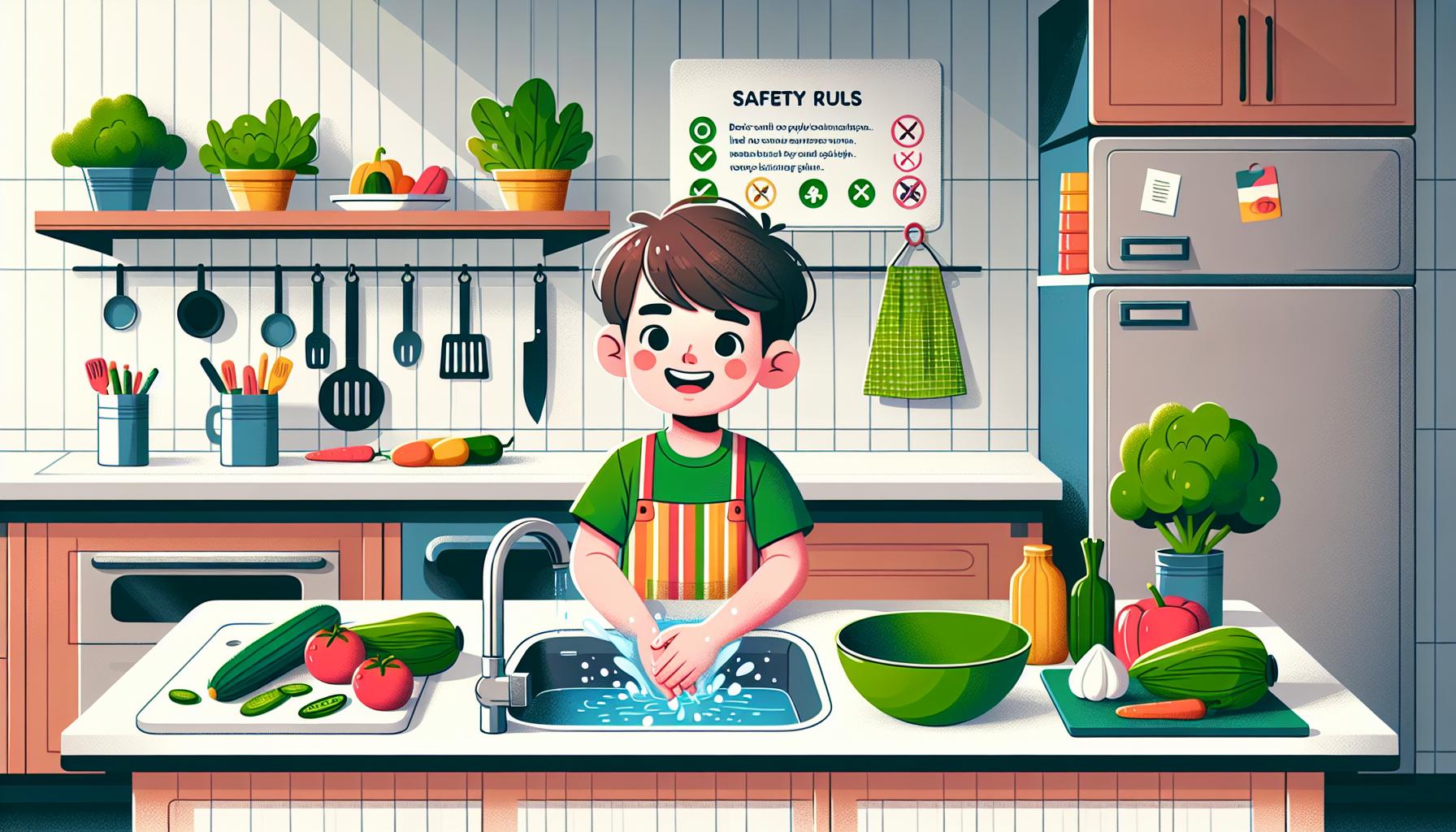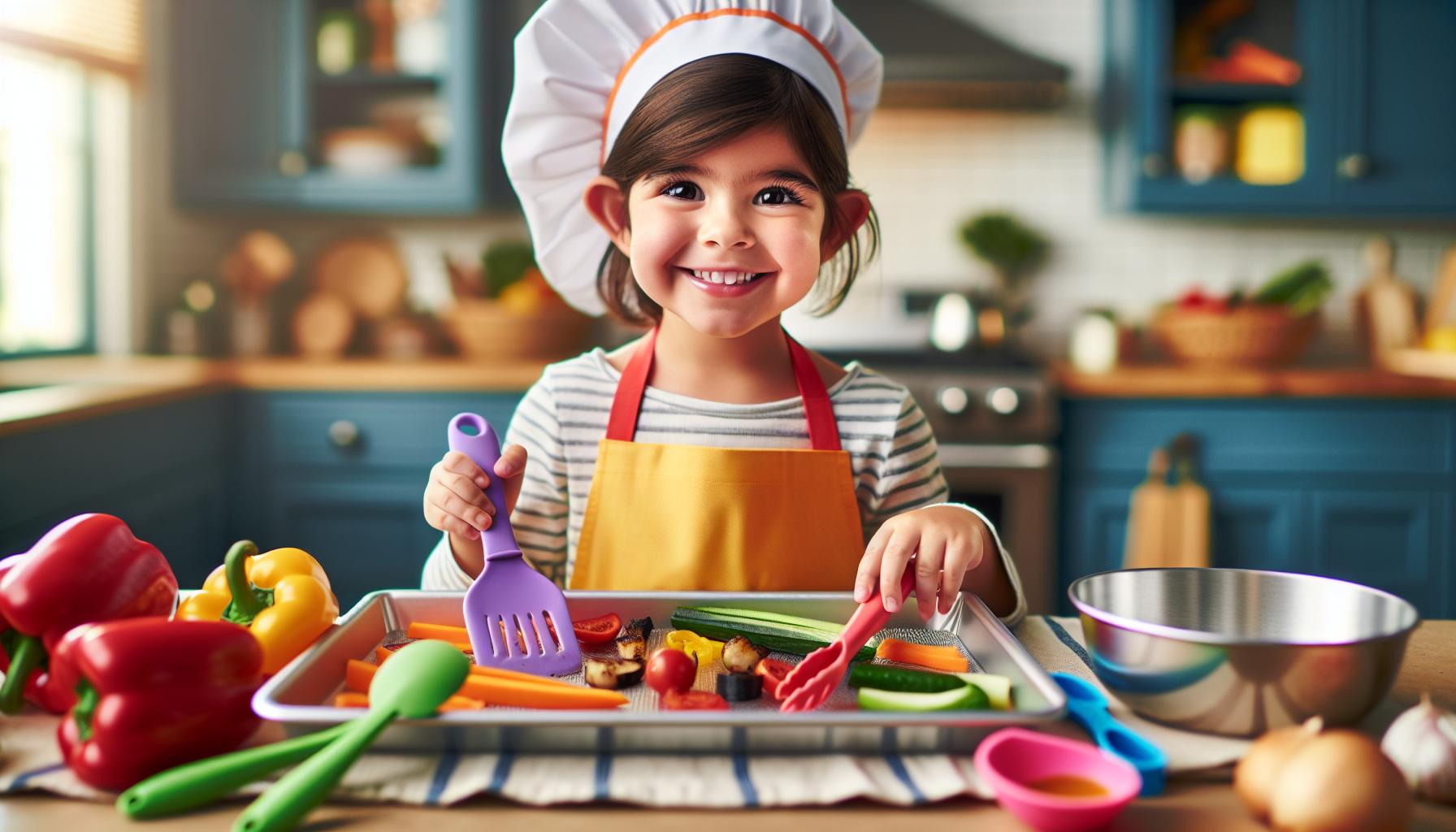
Looking for a fun way to get your kids involved in the kitchen? Sheet pan dinners offer the perfect opportunity to teach cooking skills while creating delicious family meals. We’ll show you how these simple recipes can turn dinner prep into quality family time without the usual kitchen chaos.
These easy-to-follow recipes aren’t just about making dinner – they’re about building confidence and creating lasting memories with your little ones. From seasoning vegetables to arranging ingredients on the pan your kids will feel like kitchen superstars. Plus clean-up is a breeze with just one pan to wash! What could be better than spending time together while teaching valuable life skills?
Key Takeaways
- Sheet pan dinners provide a safe and engaging way for kids aged 4-12 to learn cooking skills, with minimal supervision required for basic tasks
- Age-appropriate tasks range from simple activities like washing vegetables and sprinkling seasonings (ages 4-6) to more advanced skills like supervised chopping and following multi-step recipes (ages 10-12)
- Essential equipment includes rimmed aluminum sheet pans (18×13 inches), kid-friendly utensils with safety features, and clearly marked measuring tools at accessible heights
- Setting up designated prep stations (washing, cutting, assembly) with proper safety measures helps maintain organization and reduces kitchen accidents
- Regular involvement in sheet pan cooking teaches children valuable life skills like measuring, following recipes, kitchen safety, and cleanup responsibility while creating family memories
Why Sheet Pan Dinners Are Perfect for Cooking With Kids
Sheet pan dinners create an ideal entry point for young chefs to experience hands-on cooking. The large, flat surface provides ample space for multiple kids to participate simultaneously by arranging ingredients.
Kids aged 4-12 can safely complete these tasks with minimal supervision:
- Washing vegetables in the sink
- Tearing leafy greens into pieces
- Drizzling oil over ingredients
- Sprinkling seasonings across the pan
- Arranging meat or protein portions
- Setting timers for cooking stages
The single-pan format eliminates common kitchen hazards:
- No hot stovetop burners to reach across
- Zero pot handles extending over edges
- Reduced risk of burns from steam or splatter
- Limited sharp knife work required
- Contained workspace on one surface
Sheet pan meals build essential cooking skills through manageable steps:
- Measuring ingredients with cups and spoons
- Following recipe sequences
- Understanding food safety basics
- Learning temperature control
- Practicing kitchen organization
- Developing cleanup habits
The visual nature of sheet pan cooking helps kids grasp key concepts:
- Color changes indicate doneness
- Even spacing prevents overcrowding
- Proper portioning of ingredients
- Basic flavor combinations
- Temperature zones on the pan
- Touching different textures
- Smelling herbs and spices
- Watching foods transform
- Hearing sizzling sounds
- Tasting the finished creation
Essential Kitchen Safety Rules for Children

Creating a safe cooking environment empowers children to explore culinary skills with confidence. Here’s how to establish safety guidelines for young chefs in the kitchen.
Age-Appropriate Kitchen Tasks
Kids aged 4-6 excel at:
- Washing fruits vegetables
- Tearing lettuce leafy greens
- Sprinkling seasonings herbs
- Setting timers measuring dry ingredients
Children aged 7-9 can handle:
- Using vegetable peelers
- Cutting soft foods with plastic knives
- Greasing sheet pans
- Reading recipe steps aloud
Preteens aged 10-12 master:
- Chopping vegetables with supervision
- Operating timers independently
- Following multi-step recipes
- Arranging ingredients on sheet pans
Required Adult Supervision
Adult supervision requirements vary by task safety level:
Direct Supervision (constant watching):
- Using sharp utensils knives
- Operating hot appliances ovens
- Handling raw meat poultry
- Transferring heavy sheet pans
Indirect Supervision (nearby monitoring):
- Measuring dry ingredients
- Washing produce
- Adding seasonings
- Setting timers
Basic Safety Rules:
- Wash hands for 20 seconds before starting
- Keep hair tied back wear short sleeves
- Use oven mitts for hot pans
- Clean spills immediately
- Walk slowly no running
- Place step stools in stable positions
- Keep knife handles turned inward
- Store cleaning products out of reach
- Post emergency numbers visibly
- Keep a first aid kit accessible
Must-Have Tools and Equipment

Sheet pan dinners require minimal equipment, making them perfect for kid-friendly cooking adventures. Here’s what your young chefs need to get started safely and successfully.
Basic Sheet Pan Selection
A rimmed aluminum sheet pan sized 18×13 inches (half-sheet size) creates the ideal cooking surface for family meals. The raised edges prevent spills while the non-warping construction maintains even heat distribution. For younger children, lightweight aluminum pans offer easier handling than heavier stainless steel versions. Consider keeping 2-3 sheet pans in rotation for efficient meal prep.
| Sheet Pan Features | Benefits |
|---|---|
| Rimmed edges | Prevents spills & contains ingredients |
| Aluminum material | Lightweight & conducts heat evenly |
| 18×13 inch size | Feeds 4-6 people comfortably |
| Non-stick coating | Easier cleanup for kids |
Kid-Friendly Kitchen Utensils
Kids need right-sized tools to participate effectively in meal preparation. Essential items include:
- Silicone-tipped tongs for safe food handling
- Plastic measuring cups with clear markings
- Child-sized oven mitts with grip patterns
- Colorful mixing bowls with non-slip bases
- Vegetable scrubbers with easy-grip handles
- Kitchen timers with large display numbers
- Spray bottles for distributing oil evenly
- Sturdy cutting boards in different colors
For safe food prep, select tools with these features:
- Rounded edges on all utensils
- Non-slip grip handles
- Dishwasher-safe materials
- Break-resistant construction
- Bold measurement markers
Keep these tools in a designated drawer or bin at kid-height for easy access during cooking sessions.
Easy Sheet Pan Chicken Fajitas
Sheet pan chicken fajitas combine colorful peppers with seasoned chicken for a hands-on meal kids love to assemble. The simple preparation steps make it an ideal recipe for young chefs to practice their kitchen skills.
- Ingredient Organization (Ages 4-7):
- Line up bell peppers in three colors: red, yellow green
- Sort chicken strips into equal sizes
- Place measuring spoons near seasonings
- Set out lime wedges sliced by an adult
- Veggie Preparation (Ages 8-12):
- Wash bell peppers in cool water
- Cut peppers into strips with adult supervision
- Remove seeds with clean hands
- Place strips on sheet pan in rainbow pattern
- Seasoning Station (Ages 4-12):
- Mix 2 tablespoons fajita seasoning
- Drizzle 3 tablespoons olive oil
- Sprinkle seasoning over vegetables chicken
- Toss ingredients with clean hands
- Assembly Time (Ages 4-12):
- Spread ingredients in single layer
- Space chicken pieces evenly
- Squeeze fresh lime juice
- Set timer for 20 minutes
| Age Group | Task Difficulty | Supervision Level |
|---|---|---|
| 4-7 years | Basic | Direct |
| 8-12 years | Intermediate | Moderate |
The sheet pan method creates natural learning stations where kids practice measuring sprinkling tossing. Each step builds confidence through achievable tasks while maintaining safety standards in the kitchen.
Sheet Pan Pizza Party
Sheet pan pizza transforms an ordinary dinner into an interactive cooking experience where kids create personalized mini pizzas. This family-friendly approach lets children experiment with toppings while learning basic cooking skills.
Fun Topping Combinations
Creating a topping station gives kids the freedom to design their perfect pizza slice. Here are kid-approved topping combinations:
- Classic Combo
- Shredded mozzarella cheese
- Pepperoni slices
- Fresh basil leaves
- Italian seasoning
- Veggie Supreme
- Bell pepper rings
- Sliced mushrooms
- Cherry tomatoes
- Black olives
- Italian blend cheese
- BBQ Chicken
- Diced rotisserie chicken
- Red onion circles
- Shredded cheddar
- BBQ sauce drizzle
- Pizza Garden
- Baby spinach leaves
- Diced zucchini
- Grape tomatoes
- Ricotta dollops
- Garlic powder
Set up ingredients in small bowls at a kid-accessible height. Let children add 3-4 toppings to their section of the sheet pan pizza. Teach portion control by demonstrating how to sprinkle cheese or arrange toppings evenly.
Topping Tips:
- Pre-cook meat toppings for food safety
- Cut vegetables into bite-sized pieces
- Place cheese last for even melting
- Use measuring spoons for sauce portions
A dedicated topping station creates opportunities for kids to practice fine motor skills through sprinkling, spreading and arranging ingredients.
Colorful Sheet Pan Veggies and Sausage
This family-friendly sheet pan dinner combines vibrant vegetables with savory sausage for a delicious one-pan meal. Kids love arranging the rainbow of ingredients while learning about different vegetables and seasonings.
Easy Veggie Prep Tasks
Kids aged 4-7 can:
- Wash bell peppers under cool water
- Tear fresh herbs into small pieces
- Pat vegetables dry with paper towels
- Sort vegetables by color
- Measure olive oil with help
Kids aged 8-12 can:
- Cut sweet potatoes into 1-inch cubes (supervised)
- Slice bell peppers into strips
- Remove seeds from vegetables
- Break broccoli into florets
- Peel carrots with a Y-shaped peeler
Ingredient Organization
Set up 3 stations for efficient prep:
- Washing Station
- Large colander
- Clean kitchen towels
- Paper towels
- Scrub brush
- Cutting Station (adult supervised)
- Cutting board
- Kid-safe knife
- Vegetable peeler
- Measuring cups
- Assembly Station
- Sheet pan
- Oil sprayer
- Seasoning blends
- Tongs
- Let kids arrange vegetables by:
- Creating color patterns
- Making shapes
- Sorting by size
- Building rainbow rows
- Season ingredients:
- Drizzle 2 tablespoons olive oil
- Sprinkle 1 teaspoon garlic powder
- Add ½ teaspoon each salt pepper
- Place 4 pre-cooked sausages on top
Roast at 400°F for 20-25 minutes, rotating pan halfway through cooking time.
Note: Position oven racks in the middle position before preheating. Adults handle all hot pans oven operations.
Sheet Pan Fish Sticks and Fries
Homemade fish sticks transform dinner into a fun cooking adventure for kids ages 4-12. This kid-approved combination creates crispy, golden-brown fish alongside perfectly seasoned french fries.
Kid-Friendly Seasoning Ideas
Kids love experimenting with these simple seasoning combinations for fish sticks:
- Mix 1 cup panko breadcrumbs with 2 tablespoons Italian herbs
- Combine ½ cup crushed cornflakes with 1 teaspoon garlic powder
- Blend ½ cup grated parmesan with 1 teaspoon paprika
For the french fries, set up a seasoning station with:
- Sea salt and black pepper shakers
- Ranch seasoning packet
- Taco seasoning mix
Tips for the seasoning station:
- Place seasonings in small bowls at kid height
- Use measuring spoons marked with colored tape
- Create seasoning cards with pictures for non-readers
Seasoning tasks by age:
- Ages 4-7:
- Shake pre-measured seasonings
- Mix breadcrumbs with herbs
- Sprinkle cheese on fish sticks
- Ages 8-12:
- Measure dry ingredients
- Create seasoning blends
- Coat fish pieces evenly
- Using ¼ teaspoon measures for strong seasonings
- Counting shake counts (5 shakes per section)
- Following the “one-finger pinch” rule for salt
| Age Group | Seasoning Tasks | Supervision Level |
|---|---|---|
| 4-7 years | Shaking, sprinkling | Direct |
| 8-12 years | Measuring, mixing | Indirect |
Tips for Success and Clean-Up
- Prep Stations Setup
- Place ingredients at kid-height on the counter
- Sort items into washing, cutting & assembly zones
- Label each station with colorful signs
- Keep cleaning supplies within easy reach
- Time-Saving Organization
- Line sheet pans with parchment paper before starting
- Measure ingredients into small bowls
- Pre-cut challenging items for younger kids
- Set timer reminders for each cooking phase
- Safety Checkpoints
- Keep oven mitts next to the oven
- Place a step stool on non-slip mats
- Store sharp tools away from cooking zones
- Use heat-resistant silicone utensils
- Quick Clean-Up Strategy
- Fill sink with soapy water for immediate tool soaking
- Keep paper towels nearby for spills
- Use washable cutting mats instead of boards
- Place a trash bowl on the counter for scraps
- Storage Solutions
- Transfer leftovers to containers while food cools
- Label containers with cooking date
- Store sheet pans vertically for space saving
- Keep parchment paper rolls in easy-reach drawers
- Maintenance Tips
- Soak sheet pans immediately after use
- Remove stuck-on food with baking soda paste
- Hand dry pans to prevent rust spots
- Apply light coat of oil before storage
| Age Group | Clean-Up Tasks |
|---|---|
| 4-7 years | Wipe tables, sort utensils, put away ingredients |
| 8-12 years | Load dishwasher, wrap leftovers, wash sheet pans |
These practical strategies create an organized cooking experience while teaching kids responsibility through clean-up participation.
Conclusion
Sheet pan dinners offer the perfect opportunity to introduce our kids to the joys of cooking. We’ve seen how these simple yet engaging recipes can transform dinner prep into valuable teaching moments while creating lasting family memories.
By investing in kid-friendly tools and following safety guidelines we can help our young chefs develop essential kitchen skills. The versatility of sheet pan cooking allows children of all ages to participate making it an ideal starting point for budding culinary enthusiasts.
Let’s embrace these moments in the kitchen with our kids. Together we’ll build their confidence inspire creativity and nurture a lifelong love of cooking – all while enjoying delicious homemade meals as a family.
Frequently Asked Questions
What age is appropriate for kids to start helping with sheet pan dinners?
Children as young as 4 can start helping with sheet pan dinners under adult supervision. Ages 4-7 can handle simple tasks like washing vegetables and sprinkling seasonings, while kids 8-12 can take on more advanced responsibilities like measuring ingredients and basic cutting with supervision.
Are sheet pan dinners safe for kids to help prepare?
Yes, sheet pan dinners are very safe for kids to help prepare. The single-pan format reduces kitchen hazards, and most prep work happens away from heat sources. With proper adult supervision and age-appropriate tasks, sheet pan cooking provides a secure environment for children to learn cooking skills.
What basic kitchen tools do kids need for sheet pan cooking?
Essential tools include a rimmed aluminum sheet pan (18×13 inches), silicone-tipped tongs, plastic measuring cups, child-sized oven mitts, and tools with rounded edges and non-slip grips. All tools should be lightweight and dishwasher-safe for easy handling and cleaning.
How can parents ensure kitchen safety while cooking with kids?
Parents should establish clear safety rules, including proper handwashing, wearing appropriate attire, and maintaining adult supervision. Set up prep stations at kid-height, keep dangerous items out of reach, and teach basic emergency procedures. Always supervise oven operations directly.
What are some easy sheet pan recipes to start with?
Begin with simple recipes like Sheet Pan Chicken Fajitas, Sheet Pan Pizza Party, or Sheet Pan Fish Sticks and Fries. These recipes offer plenty of hands-on opportunities for kids to participate in measuring, seasoning, and arranging ingredients while learning basic cooking skills.
How can clean-up be managed when cooking with kids?
Line sheet pans with parchment paper for easier cleanup, keep cleaning supplies accessible, and soak tools immediately after use. Assign age-appropriate clean-up tasks to kids, like wiping surfaces or loading the dishwasher, to teach responsibility and complete the cooking experience.
What skills can children learn from sheet pan cooking?
Children learn measuring, following recipes, food safety, and basic cooking techniques. They also develop fine motor skills, understand kitchen safety, practice teamwork, and gain confidence in their abilities. Sheet pan cooking provides hands-on experience with different ingredients and cooking methods.
How long does a typical sheet pan dinner take to prepare with kids?
Most sheet pan dinners take 30-45 minutes to prepare with kids, including prep time. Setting up organized stations beforehand and measuring ingredients in advance can help streamline the process while maintaining an enjoyable learning experience.

